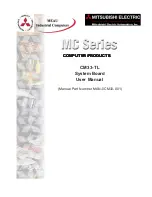
3
July 6, 2010
AN1559.0
to the victim receiver path. It taps the victim receive
path directly.
The QHx220 evaluation platform is an open loop system,
meaning that the optimization is performed manually.
With the addition of a microcontroller and some kind of
signal quality parameter fed back from the victim
receiver such as C/N, BER, RSSI, etc., the system can
operate closed loop. A simple algorithm can be coded to
optimize the gain and phase of the cancellation signal
based on the previous state of the quality parameter
provided by the victim receiver. Seed values can also be
used to improve the initial starting point state for the
optimization algorithm. Thus minimizing the number of
iterations required to achieve convergence. A look-up
table could also be implemented for systems operating
on multiple channel frequencies, but this may not be
necessary for extremely narrow band applications.
Essential Factors to Integrating the QHx220
Device into Your System
The purpose of this section is to provide some design
guidelines to ensure the successful integration of the
QHx220 into your system.
1. DO NOT exceed approximately -45dBm (exact limits
are specified within the datasheet depending on
frequency band) maximum input power of the
QHx220 device.
2. The sampled noise must be the same noise
(correlated with) as the noise that aggresses the
victim antenna. The amount of correlation is
proportional to the amount of cancellation that can
be achieved using the QHx220 device. It is often
necessary to try multiple tapping points and tapping
methods in order to achieve the best possible
correlation to the noise present in the victim
antenna.
3. Be sure to choose the correct level of pre-amplification
as described in the previous sections. If this is not
set correctly, it will limit the tuning range of the
QHx220 device and hence limit the amount of
cancellation that it is possible to achieve.
4. The delay from the noise source to the cancellation
node (via the coupling channel) should be matched
with the delay of noise source to the cancellation
node (via the sampler path). The main source of
mismatched delay is often due to the filter in the
receiver path. Using the same filter in the sampler
path is often a simple means of achieving sufficient
matching of the delay of both paths. One could also
move the cancellation node to precede the filter in
the receive path and eliminate the filter in the
sampler path. This could have drawbacks in some
applications depending on the out-of-band noise
characteristics and the noise sampling method
used.
5. The high impedance RF output of the QHx220
devices must be placed <5mm from the cancellation
node (the tapping point of the victim receiver),
otherwise resonances can occur that will attenuate
the cancellation signal. Figure 2 shows the effect of
varying the distance “L” between the QHx220 output
and the tapping point of the victim receiver.
FIGURE 2. DISTANCE FROM CANCELLATION NODE vs FREQUENCY
VI
C
T
IM ANTENN
A
TO RADIO
FREQUENCY (GHz)
d
B
(S
(2
, 1)
)
-5
-10
-15
-20
-25
0
0
0.5
1.0
1.5
2.0
2.5
3.0
L = 10mm
L = 5mm
L = 20mm
L = 25mm
L = 15mm
15
16
14
13
12
10
9
11
6
5
7
8
QHx
1
3
4
2
L
Application Note 1559



































